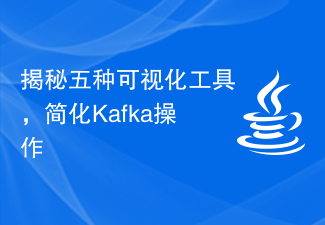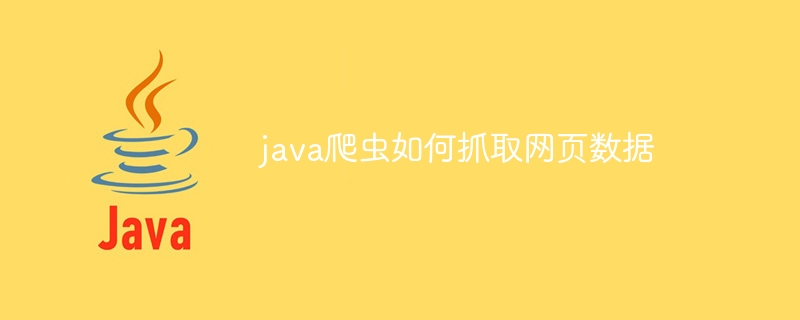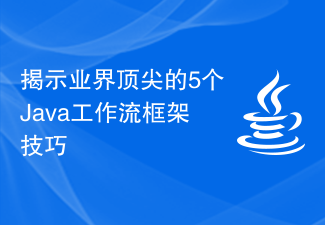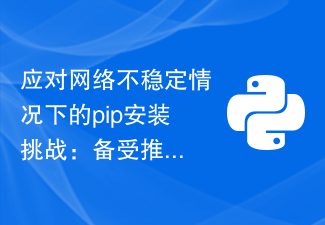 Java
Java javaTutorial
javaTutorial Java crawler technology revealed: master these technologies and easily cope with various challenges
Java crawler technology revealed: master these technologies and easily cope with various challenges
The secret of Java crawler technology: learn these technologies and easily cope with various challenges, you need specific code examples
Introduction:
In today's informatization In this era, the Internet contains massive and rich data resources, which are of great value to enterprises and individuals. However, it is not easy to obtain this data and extract useful information from it. At this time, the application of crawler technology becomes particularly important and necessary. This article will reveal the key knowledge points of Java crawler technology and provide some specific code examples to help readers easily cope with various challenges.
1. What is crawler technology?
Crawler technology (Web Crawling) is an automated data collection technology that extracts information from web pages by simulating the behavior of humans visiting web pages. Crawler technology can automatically collect various web page data, such as text, pictures, videos, etc., and organize, analyze, and store it for subsequent applications.
2. The basic principles of Java crawler technology
The basic principles of Java crawler technology include the following steps:
(1) Send HTTP request: use Java’s URL class Or the HTTP client library sends HTTP requests to simulate the behavior of humans visiting web pages.
(2) Get response: Receive the HTTP response returned by the server, including HTML source code or other data.
(3) Parse HTML: Use an HTML parser to parse the obtained HTML source code and extract useful information, such as titles, links, image addresses, etc.
(4) Processing data: Process the parsed data according to requirements, and can perform operations such as filtering, deduplication, and cleaning.
(5) Store data: Store the processed data in a database, file or other storage medium.
3. Common challenges and solutions to Java crawler technology
- Anti-crawler mechanism
In order to prevent crawlers from causing excessive access pressure to the website, Some websites will adopt anti-crawler mechanisms, such as setting User-Agent restrictions, IP bans, etc. To deal with these anti-crawler mechanisms, we can solve it through the following methods:
(1) Set the appropriate User-Agent: When sending an HTTP request, set the same User-Agent as the normal access browser.
(2) Use proxy IP: Bypass IP ban by using proxy IP.
(3) Limit access speed: When crawling data, appropriately control the frequency of requests to avoid excessive access pressure on the website.
(4) Verification code identification technology: For websites that contain verification codes, verification code identification technology can be used for processing.
- Data acquisition from dynamic web pages
Dynamic web pages refer to web pages that achieve partial refresh or dynamically load data through technologies such as Ajax. For the processing of dynamic web pages in Java crawlers, the following methods can be used:
(1) Simulate browser behavior: Use Java's WebDriver tool to simulate browser behavior, and obtain dynamic loading by executing JavaScript scripts, etc. The data.
(2) Analyze Ajax interface: By analyzing the Ajax interface of the web page, directly request the interface to obtain data.
- Persistent Storage
The data obtained during the crawler process usually needs to be stored in a database or file for subsequent analysis and application. Common persistent storage methods include relational databases, NoSQL databases and file storage. You can choose the appropriate storage method according to actual needs.
4. Code examples of Java crawler technology
The following is a simple Java crawler code example for crawling links on web pages:
import org.jsoup.Jsoup;
import org.jsoup.nodes.Document;
import org.jsoup.nodes.Element;
import org.jsoup.select.Elements;
import java.io.IOException;
public class SpiderExample {
public static void main(String[] args) {
String url = "http://www.example.com";
try {
Document doc = Jsoup.connect(url).get();
Elements links = doc.select("a[href]");
for (Element link : links) {
System.out.println(link.attr("href"));
}
} catch (IOException e) {
e.printStackTrace();
}
}
}The above code uses Jsoup The library parses HTML and gets all the links on the web page.
Summary:
This article reveals the key knowledge points of Java crawler technology and provides some specific code examples to help readers easily cope with various challenges. By learning and mastering crawler technology, we can more efficiently obtain and utilize various data resources on the Internet, bringing more value to enterprises and individuals. I hope this article has inspired you and can be useful in your future practice.
The above is the detailed content of Java crawler technology revealed: master these technologies and easily cope with various challenges. For more information, please follow other related articles on the PHP Chinese website!
 一分钟搞定!华为手机投屏到电视机方法大揭秘Mar 22, 2024 pm 06:09 PM
一分钟搞定!华为手机投屏到电视机方法大揭秘Mar 22, 2024 pm 06:09 PM在这个数字化时代,手机已经成为人们生活中必不可少的工具之一,而智能手机更是让我们的生活变得更加便捷多样。华为作为全球领先的通信技术解决方案供应商之一,推出的华为手机更是备受好评。除了强大的性能和摄影功能外,华为手机还具备了实用的投屏功能,让用户可以将手机上的内容投射到电视机上观看,实现更大屏幕的影音娱乐体验。在日常生活中,我们常常会有这样的情景:想要跟家人一
 揭秘五种可视化工具,简化Kafka操作Jan 04, 2024 pm 12:11 PM
揭秘五种可视化工具,简化Kafka操作Jan 04, 2024 pm 12:11 PM简化Kafka操作:五种易用的可视化工具大揭秘引言:Kafka作为一种分布式流处理平台,受到越来越多企业的青睐。然而,尽管Kafka具有高吞吐量、可靠性和可扩展性等优势,但它的操作复杂度也成为了使用者的一大挑战。为了简化Kafka的操作,提高开发人员的生产力,许多可视化工具应运而生。本文将介绍五种易用的Kafka可视化工具,助您在Kafka的世界中游刃有余。
 揭秘PyCharm中快速替换代码的方法Feb 25, 2024 pm 11:21 PM
揭秘PyCharm中快速替换代码的方法Feb 25, 2024 pm 11:21 PMPyCharm是广受开发者喜爱的Python集成开发环境,它提供了许多快速替换代码的方法,让开发过程更加高效。本文将揭秘PyCharm中几种常用的快速替换代码的方法,并提供具体的代码示例,帮助开发者更好地利用这些功能。1.使用替换功能PyCharm提供了强大的替换功能,可以帮助开发者快速替换代码中的文本。通过快捷键Ctrl+R或者在编辑器中右键点击选择Re
 java爬虫如何抓取网页数据Jan 04, 2024 pm 05:29 PM
java爬虫如何抓取网页数据Jan 04, 2024 pm 05:29 PM抓取步骤:1、发送HTTP请求;2、解析HTML;3、处理数据;4、处理页面跳转;5、处理反爬虫机制。详细介绍:1、发送HTTP请求: 使用Java的HTTP库发送GET或POST请求到目标网站,获取网页的HTML内容;2、解析HTML: 使用HTML解析库解析网页内容,提取所需的信息。可以通过选择器语法来定位和提取特定的HTML元素或属性;3、处理数据等等。
 Win11回收站消失?快速解决方法大揭秘!Mar 08, 2024 pm 10:15 PM
Win11回收站消失?快速解决方法大揭秘!Mar 08, 2024 pm 10:15 PMWin11回收站消失?快速解决方法大揭秘!近日,有不少Win11系统用户反映他们的回收站不见了,导致无法正常管理和恢复删除的文件。这个问题引起了广泛关注,许多用户急求解决方法。今天我们就来揭秘Win11回收站消失的原因,并提供一些快速解决方法,帮助用户尽快恢复回收站功能。首先,让我们来解释一下为什么Win11系统中回收站会突然消失。实际上,Win11系统中的
 揭示业界顶尖的5个Java工作流框架技巧Dec 27, 2023 am 09:23 AM
揭示业界顶尖的5个Java工作流框架技巧Dec 27, 2023 am 09:23 AM随着信息化时代的到来,企业在处理复杂业务流程时面临着更多的挑战。在这样的背景下,工作流框架成为了企业实现高效流程管理和自动化的重要工具。而在这些工作流框架中,Java工作流框架被广泛应用于各个行业,并且有着出色的性能和稳定性。本文将介绍业界顶尖的5个Java工作流框架,深入揭秘其特点和优势。ActivitiActiviti是一个开源的、分布式的、轻量级的工作
 应对网络不稳定情况下的pip安装挑战:备受推荐的离线安装教程Feb 02, 2024 pm 02:05 PM
应对网络不稳定情况下的pip安装挑战:备受推荐的离线安装教程Feb 02, 2024 pm 02:05 PM备受推荐的pip离线安装教程,教你应对网络不稳定情况下的安装挑战,需要具体代码示例在软件开发过程中,我们经常会遇到一些网络不稳定的情况,尤其是在使用pip安装Python库时。由于pip默认是从Python的官方仓库中下载并安装库文件,当网络不稳定或无法连接到互联网时,我们就需要采取一些方法来应对这个问题。本文将介绍如何通过离线安装的方式使用pip,以应对网
 华为手机截长图教程大揭秘!Mar 23, 2024 pm 04:09 PM
华为手机截长图教程大揭秘!Mar 23, 2024 pm 04:09 PM华为手机截长图教程大揭秘!在日常生活中,我们经常会遇到一些需要截取长图的情况,无论是保存某个网页的全貌、截取整个聊天记录还是捕捉长篇文章的全貌,都需要用到截长图的功能。而对于拥有华为手机的用户来说,华为手机提供了便捷的截长图功能,今天就让我们来揭秘华为手机截长图的详细教程。一、滑动截屏功能如果你手头有一部华为手机,那么截长图将变得异常简单。在华为手机的EMU


Hot AI Tools

Undresser.AI Undress
AI-powered app for creating realistic nude photos

AI Clothes Remover
Online AI tool for removing clothes from photos.

Undress AI Tool
Undress images for free

Clothoff.io
AI clothes remover

AI Hentai Generator
Generate AI Hentai for free.

Hot Article

Hot Tools

PhpStorm Mac version
The latest (2018.2.1) professional PHP integrated development tool

DVWA
Damn Vulnerable Web App (DVWA) is a PHP/MySQL web application that is very vulnerable. Its main goals are to be an aid for security professionals to test their skills and tools in a legal environment, to help web developers better understand the process of securing web applications, and to help teachers/students teach/learn in a classroom environment Web application security. The goal of DVWA is to practice some of the most common web vulnerabilities through a simple and straightforward interface, with varying degrees of difficulty. Please note that this software

SecLists
SecLists is the ultimate security tester's companion. It is a collection of various types of lists that are frequently used during security assessments, all in one place. SecLists helps make security testing more efficient and productive by conveniently providing all the lists a security tester might need. List types include usernames, passwords, URLs, fuzzing payloads, sensitive data patterns, web shells, and more. The tester can simply pull this repository onto a new test machine and he will have access to every type of list he needs.

Safe Exam Browser
Safe Exam Browser is a secure browser environment for taking online exams securely. This software turns any computer into a secure workstation. It controls access to any utility and prevents students from using unauthorized resources.

MinGW - Minimalist GNU for Windows
This project is in the process of being migrated to osdn.net/projects/mingw, you can continue to follow us there. MinGW: A native Windows port of the GNU Compiler Collection (GCC), freely distributable import libraries and header files for building native Windows applications; includes extensions to the MSVC runtime to support C99 functionality. All MinGW software can run on 64-bit Windows platforms.





